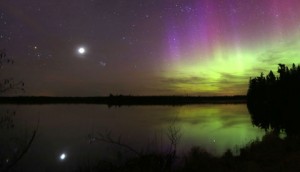During the Northern Hemisphere winter solstice, when the Sun is farthest south and sets in the southwest, can Venus ever be far enough from the Sun to appear east of the meridian?

Yes, but only when viewed from near-arctic latitudes. In late 2008, for example, Venus is the Evening Star and skywatchers in Alaska can witness this phenomenon. The rest of us can do so vicariously, right now, using SkyandTelescope.com's Interactive Star Chart. Follow the instructions for changing your location to Anchorage, Alaska, and your time zone to Universal Time minus 9 hours (that is, Alaska Standard Time). In the Date & Time box, set the date to December 21, 2008 (the winter solstice), and the local time to 3:20 p.m. Highlight the minutes, click “+” repeatedly to advance by 1-minute increments, and you’ll see that Venus remains east of the meridian even after the Sun sets in the southwest!
The same thing happens on each successive evening up to January 14, 2009, the date of Venus’s greatest eastern elongation (47° from the Sun). That evening, Venus is due south at sunset and 21° above the horizon.
— Roger W. Sinnott
 0
0







Comments
You must be logged in to post a comment.